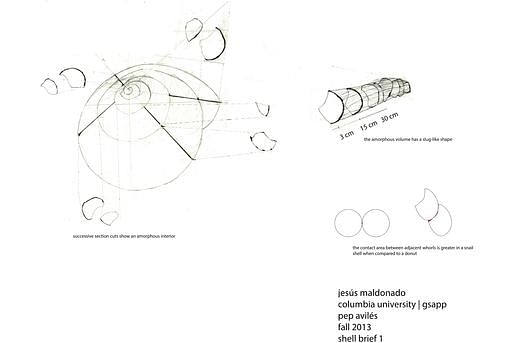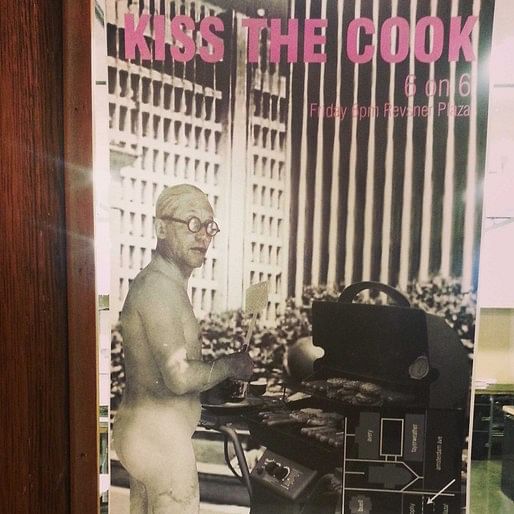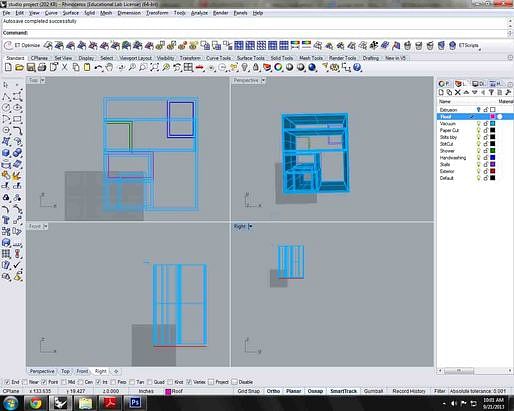
Aug '13 - Jan '14
I had no idea what I was getting into here. I have already had like four emotional breakdowns as I get software after idea after criticism after recitation after class thrown on my plate.

Sick second year model (Rafi Segal Studio)
Except for Friday morning, where I purposely slept in (not going to apologize for needing sleep), I've been getting in around 8 or 9 AM and leaving at midnight or so. At first this much work was upsetting because I realized I'm a lazy dude compared to most people here, but then I realized I liked what I did and I got over it. I don't have to come in unless I want to. I mean, look at what's happened over the past few days!
Jacques Herzog came. Grete was excited.

He attempted to encapsulate his work within major themes: simplicity, ornament, art. I think the practice of trying to go back and construct a narrative with buzzwords was a little awkward, but hey we got to see a lot of cool pictures. Here they are with some funny quotes:

"Design theory is irrelevant."

"Hong Kong has no art"
He made an argument for his work beginning out of an artistic impulse, but this upset me. His firm's projects are structurally innovative: Bird's nest is 42,000 tons of steel that has to resist 8.0 earthquakes along the twisting structure. What does he think of this? Nothing? What?
In his criticism of design theory he argued very saliently that the biggest measure of architecture is whether people actually like it. Suddenly, the postmoderns and the theorists in the room got in a huff. I thought it was amusing to see this tension.


"Good wine smells like cat piss."
The work was so moving that I was brought to tears. Yes, tears over static images of buildings. I think then is when I realized all the things I had to get to where I am today, and where I actually was. And to realize that here was this man who was showing us beautiful images of his 400th or so project...Notwithstanding the criticisms of bypassing the structural detail and his irreverence toward design theory, he is a complete master of his domain: the beautiful and humanizing. I don't think the world is a worse place for having HdM buildings; I think it is much better.
That was last Monday. This Monday there was this AMAZING lecture by Vishaan Chakrabarti. It was such a well-constructed argument that the suburb grew at best as a misguided tool of political and economic equality but has now become a (not entirely) inadvertent way to limit social and economic mobility. No one could really make a stab against it. I didn't really stay for the discussion because I had work to do, but it was funny seeing people try to find holes in something so tightly woven.


I liked his argument because it was personally appealing. I'm from McAllen, Texas: a suburban city in a region called the Rio Grande Valley. It's a place of ridiculous economic, social and health inequality. I think we're continually labeled the dumbest, fattest, most uncultured place in America year after year. I love my hometown because I must; after seeing how limiting it is, I have a vested interest in helping make it better. For example, schools there are nothing but drop-out factories with prison-esque architecture. The landscape is barren, unbuilt, and unformed. It is difficult to create community and health in an environment that forces you to be by yourself in a massive expanse: in your house, in your car, by an orange grove. I don't know what people find so liberating about being so alone in a field or a suburban "community"; to me, it is much more liberating to be surrounded by people all the time, jam packed in a subway, in a city filled with people who work too hard. There's so many ways things can happen in New York because of the density, whereas there's only so many things that can happen when your immediate environment is an orange grove.
This was all going on leading up to our first review.

We had to deconstruct a shell.
Studio, looking back, was super funny. We had people crazily trying to analyze the history of a snail shell, people sanding too many shells (calcium carbonate being sloughed off for 5 hours a day...). People tried modeling it in Rhino, and doing stuff I didn't understand (but am determined that I will!) in Grasshopper. It seemed like some were trying to get points for being the most design-y. I think the best part was the hoarders: some people had upwards of 20 shells stored away in their cubbies.
It was at this interval that I went outside and started crying, because I felt like I was in a madhouse. I am still recovering from the snail shell emotional rollercoaster. I felt really removed from the motion of the school, having to sit and listen about far-removed Baroque architects in history, being exposed to design "theory" and now snail shells being sanded all the time.
I realized that this is actually why I am supposed to be here. Graduate school isn't pretty and fun and introductory. It is loud and heavily focused, which is good. I am not here to read a college textbook on structures or history and regurgitate what other people know about a subject through slides. I am here to do real work, to learn how structures are done in the real-world, to dig in an archive for historical work, and to go through the pain to develop a personal argument for my existence. Sounds dramatic, but that's what we're really doing here: to get that breadth and combine it with a laser focus of what I want to do with my life. I realized that I probably never want to be a historian or an academic in the purest sense, and that I needed to stay true to myself. I do respect their work, but I don't want to pursue it. I think some of my principles will be: functional, no pretense, analytical, (keep it simple, stupid) and get a little wild. In other words, theorists and historians probably hate me, but I actually want to learn how buildings are constructed and make some powerful moves on the social environment. I cannot stand that we have let architecture become the provenance of the privileged, with no rigor and the notion of an irresponsible architect. I don't want to make pretty buildings, drawings, or words. I want to make good ones.
I used my hand and drafted/traced on a huge light table. I knew that at such a digital school I would probably be ripped apart for doing so. My critics were nonresponsive to my project and I think everyone thought it was too basic. Whatever, this was probably going to be the last significant hand-drawing I made for a while anyways. I tried coming up with a visual hypothesis about how the thing worked, and just had fun.

Lastly, the best part about this school is the booze. I am not really kidding. The fact that we can drink makes the school a lot better, because we have the space to be able to talk informally which is very important. Some of the most important conversations about projects have happened on the way to, or with the help of booze. It also makes me realize how damn interesting everyone here is. Very smart people. That being said, me and my friend Jack Daniels had a little tousle last night, and it's time I get started on some studio stuff.
We're making bathrooms and all I have are six boxes. Yikes. Pin-up on monday, and I need some more product.

A blog that attempts to record the overload of people, perspectives and projects that run through the Graduate School of Architecture, Planning, and Preservation at Columbia University. 3 years of M.Arch studies from 2013-2016. Lectures. Tours. Crits, reviews, juries. Studio transgressions. Contentious viewpoints. Facts and fiction, with a side of parti(e)s.



1 Comment
Love your blog, Jesus! Keep writing. -Dee
Block this user
Are you sure you want to block this user and hide all related comments throughout the site?
Archinect
This is your first comment on Archinect. Your comment will be visible once approved.